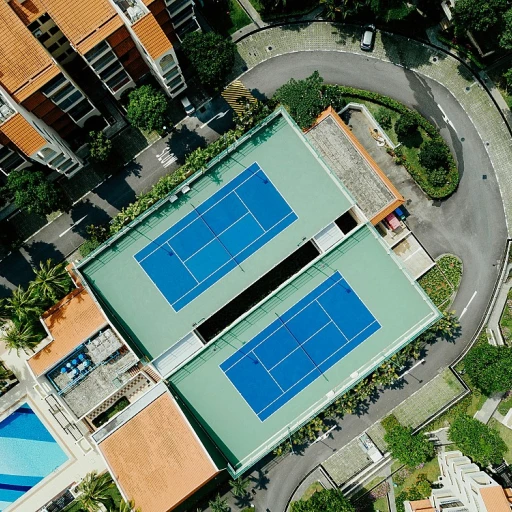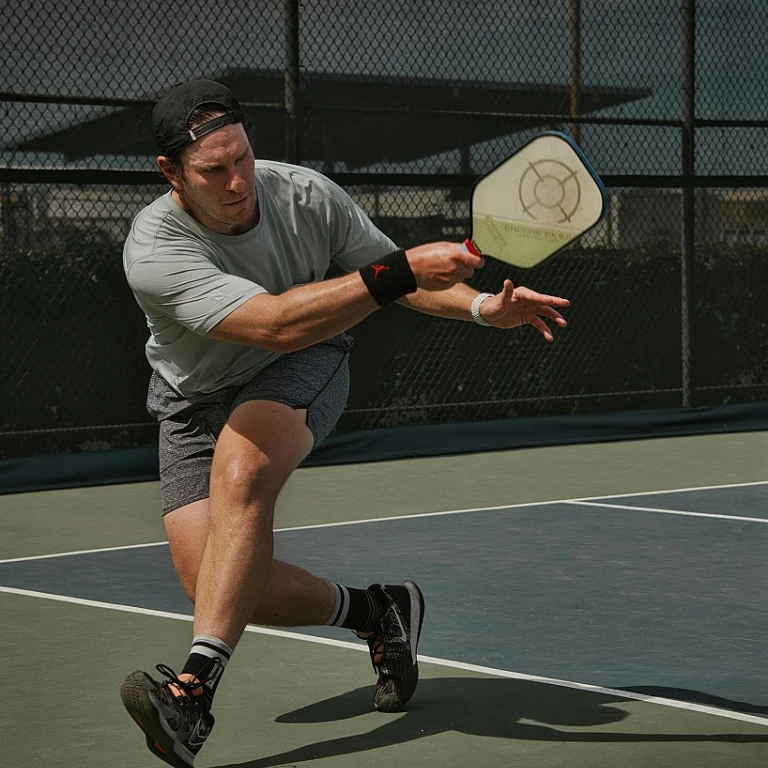The Basics of Pickleball League Standings
Understanding Pickleball League Structures
Pickleball leagues are gaining significant popularity as more players come together to enjoy the fast-paced and engaging nature of the game. The league structure forms the backbone of how matches and points are organized, influencing players' movements up and down the ladder. Here's how.
- Types of Leagues: Ladder and Round Robin
In a ladder league, players or teams compete to move up the ladder by challenging those a step higher or defending their position. The end goal is to improve their position on the pickleball ladder by frequently engaging in matches.
Round-robin leagues, in contrast, are based on a sequence of matches where each player or team in a pool plays against every other team or player. This ensures that players gain exposure to different skill levels, enhancing their play through varied challenges and experiences.
- Role of Divisions and Skill Levels
Leagues are generally divided based on skill levels and divisions, allowing players to compete with those of similar ability. This ensures that play remains competitive and enjoyable for all participants. As players improve their game, they may advance to higher divisions, facing opponents with greater skill.
- Weekly Matches and Scheduling
Whether it's a step ladder or round robin, attending weekly matches is crucial for maintaining and improving standings. Each week brings an opportunity for players to refine their skills in the volley zone, adjust strategies, and potentially move up the league ladder.
- Importance of Points in Standings
Points are the primary metric used to determine rankings within a league. Team points accumulated from matches, whether victories or well-played losses, contribute to overall standings. As such, understanding how points are allocated can be key to strategic play.
For those considering joining pickleball leagues, understanding the intricate mechanisms of league standings can be an empowering first step. If you're interested in honing your skills further, you might want to
explore nearby lessons to elevate your play and improve your league performance.
Point Systems and Their Impact
Decoding Point Systems in Pickleball Leagues
Understanding the point systems in pickleball leagues is crucial for participants. The points decide your team or player's position in the ladder league and impact their chances of moving up the ranks or securing a spot in the playoff rounds. Here’s a breakdown of how these points systems generally work in pickleball leagues:
- Individual Match Points: Points are often awarded based on the outcome of individual matches. Winning a match will typically earn you a set number of points, while losing might earn none or just a few consolation points, depending on specific league rules.
- Pool Play Points: In leagues that employ a round robin format or pool play system, wherein players or teams are divided into smaller groups or pools, accumulating points across matches becomes essential. Here, each victory adds to your overall tally, impacting your position in pool rankings.
- Cumulative Points Across Rounds: Many leagues incorporate a step-by-step point accumulation process across multiple rounds or weeks. This means your overall performance in the league determines your final standings as points from each match, week, or even entire rounds, pile together.
- Skill Level Adjustments: Certain leagues adjust points to account for varying skill levels among players or teams. This ensures a fair competition where points reflect the difficulty faced during matches between different skill-level opponents.
Understanding these point systems helps players and teams craft better strategies not just to win individual matches but to excel in the league standings. By knowing how points contribute to a player's move up the ladder, players can focus on areas that significantly impact their team's success. For those wanting a deeper understanding of how these point systems play a role within specific leagues, the
Exploring the Palm Beach Pickleball League offers a detailed guide that can serve as a valuable resource.
Factors Influencing Standings
Elements Influencing League Standings
In a pickleball league, several factors interact to influence the standings and determine the overall ranking of players or teams. Understanding these elements is crucial for players who are navigating ladder leagues and striving to climb the hierarchy.
- Match Outcomes
- Each match played feeds into the league standings based on the points awarded for wins, losses, and ties. The cumulative team points often decide placements on the ladder.
- Skill Levels
- Skill level differences among players and teams can significantly impact league dynamics. More skilled players are likely to dominate, affecting the standings in ladder leagues. To maintain competitive balance, leagues might utilize pools or brackets organized by skill.
- Frequency and Number of Matches
- The number of matches played each week and throughout the season contributes to movement on the ladder. More playing opportunities usually allow players to improve their rankings gradually.
- Participation in Ladders
- Players’ consistent involvement, such as joining pickleball ladders or participating in step ladders, increases their chances of moving up. Regular play and success in the game can lead to promotions and improve league standings.
- Round Robin Formats
- Many pickleball leagues adopt formats like the round robin, allowing players to encounter numerous opponents. This exposure ensures a fair assessment of each player's ability, influencing their rank according to consistent performance.
- Volatility of Court Conditions
- Court conditions and the physical settings where matches are played may occasionally affect outcomes. Experienced players adapt better, but inconsistent surfaces or unexpected weather can influence match results.
Understanding these elements can provide insight into how players can take strategic steps, adjusting their gameplay to improve their standings over time. By identifying where their performance may lag, teams and individual players can focus efforts on areas that will lead to tangible advancements in league rankings. For those deeply invested in the sport, this strategic approach is key in their quest to achieve the coveted trophy in pickleball competitions.
Achieving the coveted pickleball trophyCommon Challenges in Ranking
Challenges in Ranking Teams and Players
Pickleball league standings may seem straightforward at first glance, but various challenges can complicate the ranking of teams and players. Understanding these difficulties is crucial for those who play a role in managing or participating in a league.
One common challenge is dealing with players of differing skill levels. Leagues often involve a mix of newcomers and seasoned competitors, making it a test to rank individuals fairly. The disparity in player skills can skew results, especially in ladder leagues or step ladders where players move up or down steps based on their performance.
In ladder leagues, for instance, a match between a top-level player and a less experienced one can disrupt the usual flow of the ladder, impacting the game experience for everyone involved. This inconsistency in matches can lead to an inaccurate representation of a player’s true abilities when viewed in the pickleball ladder.
Another factor to consider is the frequency of matches played within a league. Players who have the time to participate in multiple matches each week may accumulate points more rapidly than others, affecting their standing more as a reflection of availability rather than solely skill. Consequently, team points may not always reflect the talent level or commitment of a team.
Furthermore, the type of matches—such as round robin, where teams or players play against each other once in a pool—can present its own set of issues. The round format ensures every player participates in a more comprehensive range of matches, yet calculating standings from these outcomes can present unique quirks as the number of rounds varies weekly.
Lastly, external factors like weather conditions or the quality of the courts can create inconsistencies in the play pool, impacting results and subsequently standings. Missing matches due to a rained-out court, for example, can unfairly hinder the progress of a team that otherwise could climb the rankings.
Navigating these challenges and understanding the nuances of pickleball leagues can help players, coaches, and organizers foster a more equitable and competitive environment for everyone involved.
Strategies for Improving Standings
Effective Approaches for Climbing the Ranks in Pickleball Leagues
Focusing on strategies that improve standings is critical for anyone involved in pickleball leagues. Whether it's a ladder league, round robin, or within a play pool, understanding how points affect your standing can shape your approach on the court.
One primary strategy involves consistent participation. Regularly playing matches can boost your presence and skill level, allowing players to accumulate the necessary points to advance. Participating every week and playing with different teams in various pickleball ladders ensures exposure to a variety of play styles.
Next, teamwork plays an indispensable role, especially in team-oriented games. Building strong player chemistry during matches is vital as it translates to better performance and more points accrued by the team. Focus on exceptional coordination and understanding within the volley zone or during doubles play.
Players should also consider their skill levels and target their areas of improvement. Joining pickleball clinics or working with a coach to refine techniques can translate into better results during rounds. As each player moves up the ladder and gains more experience, they will encounter players of higher skill levels, gradually contributing to an increased overall ranking.
Finally, adaptability is key. Recognizing patterns in opposing players and adjusting strategies during gameplay can offer a tactical edge. As such, players move through the ladder league not only by advancing their physical game but also by sharpening their mental acuity.
These methods, when employed effectively, will help players navigate the complexities of pickleball league standings, ultimately aiding them in moving up the step ladder in a competitive environment.
Analyzing Standings for Future Predictions
Deciphering the Patterns for Future Performance Predictions
Understanding pickleball league standings offers significant insights into predicting future performance trends for players, teams, and leagues as a whole. By recognizing patterns and connecting dots about how the ladder league operates, one can make educated assumptions about future match outcomes.
First, carefully examining the point dynamics can reveal fluctuations in team points over an entire round robin season. Regular scrutiny of the steps within each ladder showcasing varying skill levels will highlight which players move up the ladder and which may need to adopt new strategies.
Observing how teams and players perform under varying conditions, such as adjustments in play pool or transitions across different courts, is paramount. This could influence and redefine how pickleball players choose to strategize upcoming matches. Moreover, reflecting on performance across different matches within a step ladder format can unearth potential weaknesses or strengths in a player’s game, offering opportunities to optimize their approaches in future games.
Utilizing ladder leagues and ladder techniques becomes even more insightful when evaluating collective data over the course of weeks, if not months. It fosters a comprehensive view of volatility across player standings, allowing for a deeper understanding of how shifts in the volley zone control during key matches alter overall player positioning.
When these league details are synthesized at a granular level, they ripple into broader implications for securing victories in subsequent pickleball games. A well-analyzed move step within a skill level not only reinforces a player's tactical acumen but also provides leverage in competitive ladder environments, influencing who may ultimately dominate future leagues.
Engagement with these aspects promotes a proactive approach to predicting where a pickleball team's strategy might lead, thereby equipping participants with better insights and expectations for upcoming rounds.

